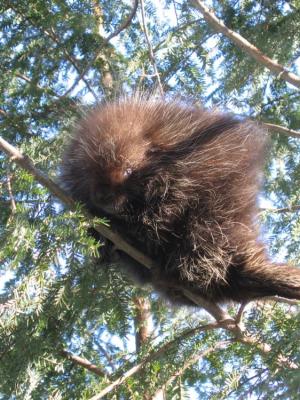Our enduring fascination with endearing “quill pigs.”
- Tags:
- Wildlife

In spring, porcupines seek the tender leaves of sweet maples and juicy sapwood beneath the bark of birch and poplar twigs. Porcupine at Black Mountain Forest Reservation, Mount Kearsarge in Sutton. Photo Danny Richardson.
I collect porcupine stories. It seems everyone who has lived in rural NH has got at least a few. The porcupine tale genre is predictable: disappearing garden or orchard produce, damage to structural lumber, repeated bouts of quills in noses of domestic dogs, and lastly, firearms. Often the tales follow nearly the same progression.
Porcupines have a diverse palette – from bark and lumber in winter to tender green shoots and leaves in spring and summer.
Porcupines return each day to climb a winter “station tree” to eat tree bark or conifer needles. Stunted, contorted “Bonsai” hemlocks in the forest are the result of repeated winter browsing by porcupines and often indicate a rocky den or coarse stonewall habitat nearby. The porcupines’ austere diet of bitter needles and hemlock bark is a diet of desperation to get though the long winter.
What many people don’t realize is that porcupines readily migrate to greener pastures in spring. An acquaintance lost several beds of early lettuce, peppers, and flats of impatiens. Summer was uneventful. But then in fall, she lost all her cucumbers, zucchinis, butternut squashes, and eggplants. She remained mystified until her backyard surveillance camera revealed a porcupine raiding her unfenced raised beds.
In May, porcupines seek the tender leaves of sweet maples and juicy sapwood beneath the bark of birch and poplar twigs. As more tender greens become available, porcupines migrate to fields, pastures, and even ornamental trees. I’ve found several juvenile “porcupette” grazing on dandelions and clover at dusk in our open pasture.
Porcupines are slow, shy, and prefer to avoid confrontation with people and dogs. When confronted at close range, they tuck their heads like an armadillo, turn tails, and bristle with quills – A large, rodent-family fortress bristling with defensive armament!
Porcupines are accessible to us. Compared to other wildlife, they are relatively abundant, conspicuous, slow-moving, and prone to habituate areas inhabited by people and pets. They’re almost “cute” with an endearing, comical quality about their manner. It’s easy to be ambivalent about them: You love them for their endearing traits while hating them for their damage to gardens, trees, structures, and pets.
I’ve battled porcupines eating a special pear tree. They feed by bending and breaking branches. The porcupine, perched on a branch high above, remained untroubled by my barking dog. Although I brandished a rifle in a flourish of intimidation, I just couldn’t pull the trigger. The solution was to fence the tree by wrapping chicken wire around tall grade stakes placed in a twelve-inch radius around the trunk.
The salt block in our sheep pen proved irresistible. One morning, I found our large and agitated ram with his forehead bristling with quills. I still wonder how far he butted that startled quill pig! Never saw him again.
Naturalist Dave Anderson is director of education and volunteers for the Society for the Protection of New Hampshire Forests. He may be reached via e-mail at danderson@forestsociety.org.
My Brief Romance with a Porcupine
- by Esther Cowles

I fell in love again around Valentine’s Day. My husband of 20 years introduced me to my new heart-throb, having snapped his photo in the woods behind the manure pile. When this visitor returned two days later, I was smitten. By day three, it was a full-on crush. I couldn’t keep my eyes off him. I spent one full day spying like a Peeping Tom from my kitchen window. I watched him eat, nap, go out on a limb. What I wanted most of all was to follow him home. I needed to know where this guy lived!
I named him Pokey. Not for the obvious reason of his quills, but for his waddling gate. He doesn’t go anywhere fast. Yes, I was in love with a juvenile porcupine. I told friends and family.
By day five, his habits started to bother me. He spent his days nibbling away at the only hemlocks I really care about, the young trees that provide cover to the songbirds flitting to and from our feeders. Soon gaps emerged where dense branches once hung. I consulted a book and learned that porcupines return to the same tree consistently. My friends and family were as consistent in their advice to me: Shoot him.
“You don’t want a porcupine around your house…your dogs…your cats…your horses,” they said. “Do you have any idea the damage they can do? Or what your vet bill will be?”
Their arguments roused my senses like a Jim Croce song from childhood. I grew up in the North Country, raised in a community that had long ago espoused a utilitarian approach to nature. Of course you shoot porcupines that encroach on your home.
But shooting Pokey just didn’t sit right with me.
Soon, I was suffering the mood swings of a hot romance gone bad. Every day, I yearned to see him, but I hated how he was damaging my trees. I wanted to get rid of him, but knew I would miss watching this rite of late winter. Who am I to play favorites, picking trees and birds over a porcupine? My heart said leave him alone, let nature take its course.
This decision was made more difficult because it refuted the ways of my upbringing. I value that my conservation ethic is deeply rooted in my rural rearing. My fondness for Pokey compels me to see that my ethic is reshaped by my adult experiences, now spent in the fragmented forests of Hopkinton, where we humans share more closely the habitats of our wild friends. I will seek ways to coexist peacefully and maybe even enjoy a brief wild romance.
